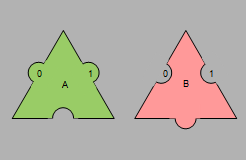Imagine the elements of a group-like structure as puzzle pieces with essential two sides, an IN-side and an OUT-side.

You can compose two such elements in two obvious ways:

Now consider triangular puzzle pieces with two kinds of sides - IN and OUT - with at least one IN- and one OUT-side. These are 2-simplices with a non-trivial partition of their sides.

As long as two sides of the same kind are not distinguished (i.e. the simplices are symmetric), there are again two ways to compose two such elements:


But when two sides of the same kind are distinguished:

a single operand + doesn't suffice anymore. One has to specify which of the (eventually) two OUT-sides of A are two be plugged into which of the (eventually) two IN-sides of B:

I wonder:
- In which specific (algebraic or simplicial resp. topological) contexts do such asymmetric "pieces" appear?
- How then is the problem of notation solved, especially: how are "words" of such pieces symbolically written down (which is trivial for group-like structures by the use of + or $\circ$ or even no symbol at all).
